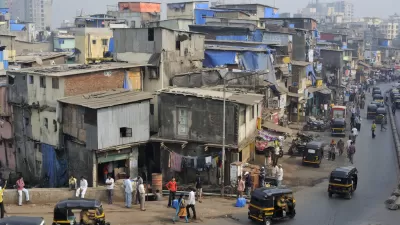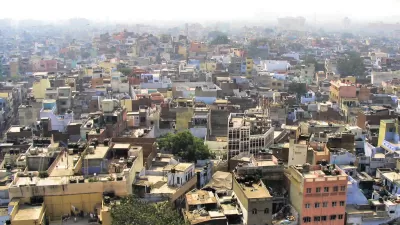Watching Slumdog Millionaire, the Oscar winning film of 2008 that is being released on DVD today, can be a bracing experience for those accustomed to the conveniences of Western living. The destitute living is accurately and graphically depicted and is all too real for those that have seen it. Yet, the real danger is letting the poverty obscure a larger, perhaps more important lesson about urban places: Many of these urban slums are functioning, productive cities in their own right, and represent an intergenerational path toward economic improvement.
Watching Slumdog Millionaire, the Oscar winning film of 2008 that is being released on DVD today, can be a bracing experience for those accustomed to the conveniences of Western living. The destitute living is accurately and graphically depicted and is all too real for those that have seen it. Yet, the real danger is letting the poverty obscure a larger, perhaps more important lesson about urban places: Many of these urban slums are functioning, productive cities in their own right, and represent an intergenerational path toward economic improvement.
This became vividly apparent to me during a 2005 visit to one of Asia's largest urban slums: Dharavi, in Mumbai (Bombay), India. Dharavi is a sprawlingly dense urban area of nearly one million residents on just 2.5 square miles. The slum alone would come close to breaking into the top 10 largest cities in the United States. It's about the size of Detroit or San Jose but smaller than Dallas. Yet it is nested in a urban agglomeration of nearly 20 million people (the size of the New York-Norther New Jersey-Southwest Connecticut metropolitan area).
With just about 30 square feet per resident, Dharavi may well rank as the world's most densely settled subcenter. American's simply can't fathom the depth of this kind of urbanity because we have nothing to compare it to, not even Manhattan.
Yet, unlike many Western (and US slums), Dharavi is not an economic wasteland. The huts, scarcely 100 square feet for each family, are resilient, strong enough to survive the monsoons and store "inventory" for vibrantly practical slum businesses such as plastic recycling, pottery, restaurants, tailors, tea shops, clothes washing and hundreds of others. Peeking inside one of these huts finds that some families have tapped electricity (illegally) to power a TV set, hot plate, radio or a DVD player. While Dharavi houses the poorest of the poor, it also makes do for policeman, domestic servants, and construction workers.
So, rather than looking out over a vast expanse of desolation, I saw a city teeming with life. I saw an amazing display of human ingenuity, patience, and perseverance. A little Hindu determinism mixed in with the natural instincts of people to trade and work had created surprisingly robust, resilient, safe, and stable urban economy.
Despite this urban vibrance, the slum is not a place where most people want to live. This is a make do lifestyle. There is no running water, and sewers are open. A Westerner without the proper immunizations probably would struggle to survive let alone adapt. Most of us wouldn't want to raise our children here. In the words of a regional advisor to the World Bank who accompanied me on my tour, the residents of Bombay's slums are not so much "income poor, as they are quality of life poor.
In Mumbai, the next generation's quality of life will improve through small but highly meaningful enhancements in their everyday living such as adding another 100 square feet to the living space of a family, adding a half wall inside a an apartment to give a husband and wife a little privacy, raising the ceiling by four feet to create a room for children or enough space for a relative's family.
As the city's economy continues to generate wealth, the slumdweller's quality of life will improve too as they can afford the two and a half dollars a month for legal electricity. Disease will be kept in check by another two and a half dollars a month for running water and a private toilet.
While I developed a keen sense of empathy for Mumbai's slum dwellers, I didn't feel much pity. In Dharavi's teeming slums lies Bombay's economic future. Indeed, all great cities, including those in the West, have gone through these stages at one point or another. While these improvements may seem minor, even trivial, from our perches in the West, they serve as a stark reminder of the tradeoffs people make to take advantage of the opportunities cities provide.
For more on the economic and social role of informal settlements and slums, I highly recommend Robert Neuwirth's Shadow Cities. For a narrative that specifically captures the pulse of Mumbai's slums, it would be hard to do worse than Gregory David Roberts' novel Shantaram.

Alabama: Trump Terminates Settlements for Black Communities Harmed By Raw Sewage
Trump deemed the landmark civil rights agreement “illegal DEI and environmental justice policy.”

Planetizen Federal Action Tracker
A weekly monitor of how Trump’s orders and actions are impacting planners and planning in America.

The 120 Year Old Tiny Home Villages That Sheltered San Francisco’s Earthquake Refugees
More than a century ago, San Francisco mobilized to house thousands of residents displaced by the 1906 earthquake. Could their strategy offer a model for the present?

In Both Crashes and Crime, Public Transportation is Far Safer than Driving
Contrary to popular assumptions, public transportation has far lower crash and crime rates than automobile travel. For safer communities, improve and encourage transit travel.

Report: Zoning Reforms Should Complement Nashville’s Ambitious Transit Plan
Without reform, restrictive zoning codes will limit the impact of the city’s planned transit expansion and could exclude some of the residents who depend on transit the most.

Judge Orders Release of Frozen IRA, IIJA Funding
The decision is a victory for environmental groups who charged that freezing funds for critical infrastructure and disaster response programs caused “real and irreparable harm” to communities.
Urban Design for Planners 1: Software Tools
This six-course series explores essential urban design concepts using open source software and equips planners with the tools they need to participate fully in the urban design process.
Planning for Universal Design
Learn the tools for implementing Universal Design in planning regulations.
Clanton & Associates, Inc.
Jessamine County Fiscal Court
Institute for Housing and Urban Development Studies (IHS)
City of Grandview
Harvard GSD Executive Education
Toledo-Lucas County Plan Commissions
Salt Lake City
NYU Wagner Graduate School of Public Service





























